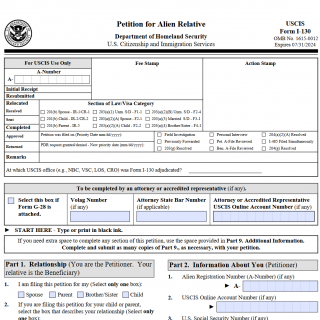Form I-130. Petition for Alien Relative
The I-130, Petition for Alien Relative form, is a crucial document in the United States immigration process. Its primary purpose is for U.S. citizens or permanent residents to establish a familial relationship with an alien relative who wishes to immigrate to the United States.
The I-130 form consists of several parts, including:
- Personal information about the petitioner (U.S. citizen or permanent resident)
- Information about the beneficiary or alien relative
- Details about the relationship between petitioner and beneficiary
- Additional information, such as multiple beneficiaries or interpreter/typist help
- Signature and declaration from the petitioner
Some key fields of the I-130 form include the petitioner's citizenship or residency status, beneficiary's country of birth, relationship between petitioner and beneficiary, and any pertinent documents supporting their relationship.
The I-130 form is compiled when a U.S. citizen or permanent resident wishes to sponsor a family member for immigration. The parties involved in this process are the petitioner (U.S. citizen or permanent resident) and the beneficiary (alien relative).
When completing the I-130 form, it is important to provide accurate information and ensure all required supporting documentation is submitted along with the form. This may include birth or marriage certificates, passport pages, photographs, or proof of legal residency status.
The I-130 form allows U.S. citizens or permanent residents to sponsor family members in their immigration process, thus supporting family reunification and promoting a stable family life.
Incomplete or inaccurate information can result in delays or denials of the petition. It is crucial to double-check all information and ensure that you submit all necessary documents.
The I-129F, Petition for Alien Fiancé(e), is used by U.S. citizens to sponsor their foreign fiancé(e)s for a K-1 visa to enter the United States and get married. The I-130 and I-129F serve different purposes, with the I-130 focusing on family members in general and the I-129F specifically for fiancé(e)s.
The I-130 form should be submitted to the United States Citizenship and Immigration Services (USCIS) along with the required supporting documentation and filing fee. After submission, USCIS will review the petition and notify the petitioner of their decision or any further requirements. The approved petition, together with other immigration application files, will be stored by the USCIS.

